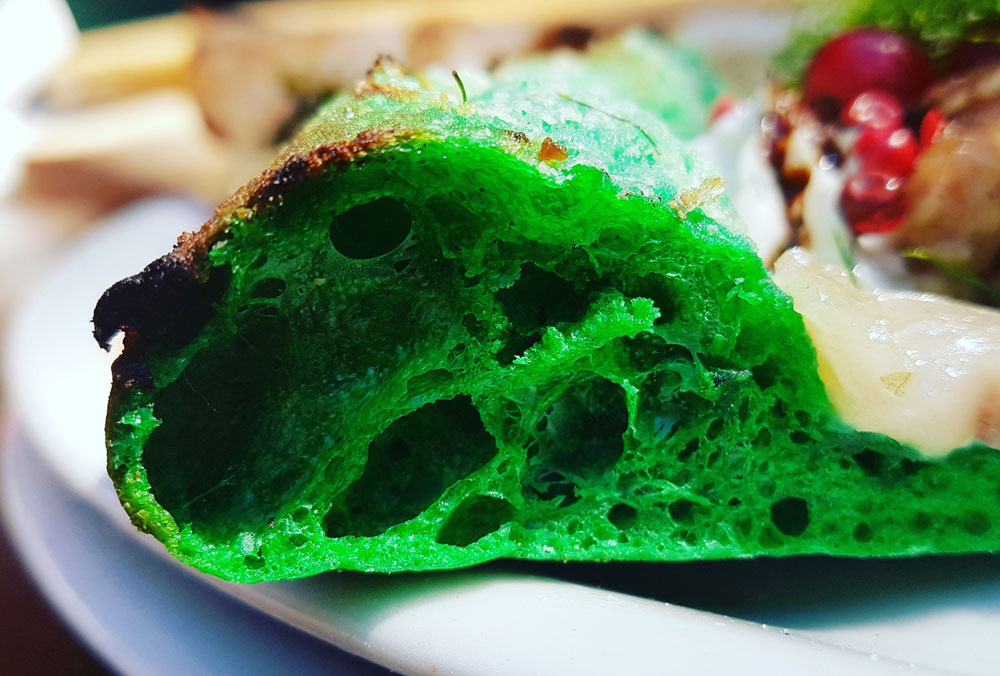Today in Italy, it is not uncommon for pizzerias to have two, three, four or more types of pizza crust on offer. The choices are not designed for handling different preparation methods—hand-stretched vs. pan, for example—but are based on the fundamentals of the pizza dough itself. Pizza made with ancient grains or stone-milled flour honors an ancient past with promised health benefits, while other kinds of dough contain added ingredients to give a unique taste, color and smell to the pizza. But how did Italy go from a country fiercely defending its food tradition just 10 years ago to a place that now abounds with black, red, purple and green tinted dough?
“This trend started five to six years ago, due to so many pizza maker associations,” says Marianna Iodice, a journalist at Ristonews.it in Monopoli, Italy. “Pizza makers all over Italy began to experiment with different kinds of flours and share their results on social media. At the same time, print and online media such as Pizza & Core magazine gave information about how to make these new products. I can tell you that a lot of pizzerias offer alternative dough types today—it is a general trend happening all over the nation.”
 |
|
Stefano Miozzo from Pizzeria Al Borgo in Cerea, Italy, is the 2018 reigning World Champion for Pizza Classica. His winning pizza (pictured below) has a purple tint due to the addition of Amarone wine, a specialty product in the Verona area. |
“Pizza makers try to find a way to make themselves unique in the market,” adds Annalisa Tardioli, marketing manager at Molini Spigadoro in Bastia Umbra, Italy. “Using specialty flour is one way to do that. For example, the addition of red or black venere Italian rice flour to wheat flour gives finished dough a beautiful color and fragrance and creates a lower-gluten result. “Pizza made with hemp flour has no THC, but it adds a light green color,” Tardioli says. “These pizzas aren’t sold in pizzerias very often. They are more for showing off on social media.” Other standout pizza experiments include the addition of spirulina, red cabbage and red chili peppers to an otherwise normal pizza flour.
 |
| Miozzo’s pizza, topped with foie gras, caviar and slices of pigeon, is the most expensive pizza on the menu, at 40 euros each. |
Specialty dough is becoming so much the norm in Italy that a pizza dough made with red wine took first place in the Pizza Classica division at the 2018 World Pizza Championships. First-place winner Stefano Miozzo, from pizzeria Al Borgo near Verona, regularly makes a small batch of dough with Amarone wine at the store for the adventure-seeking customer. Miozzo is a prime example of Italians’ newfound lust for trying new specialty flours and dough types. He currently uses some 12 different types of flours from some of the most-known to the smallest local mills. “I’m not connected to any particular mill, and I like to try things out,” Miozzo says. “If I have to change because there’s something better on the market, I do it.”
In America, the trend is also starting to catch on, but more slowly. “Some Italian pizza makers are bringing the trend to New York, but only a few so far,” Tardioli explains. In the meantime, new specialty flour mixes are coming to the American market: Pinsa Romana, for example, combines soy and rice flour to make traditional Roman-style pizza. If you are trying out new and incredible ways to prepare and present your dough, share it with us online using our social hashtags, #pmqpizzamag and #pizzatvdotcom.















